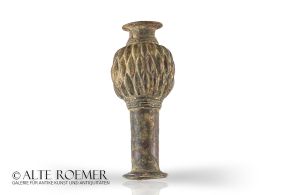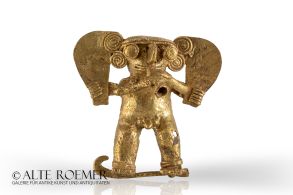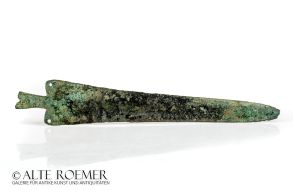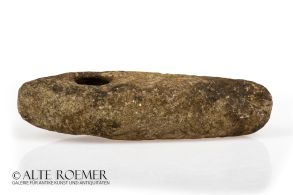Available - Katalog Lampen - Photo gallery
Image database with photographs of ancient art and antiquities
Our image database provides photographs of ancient art and antiquities for press releases as well as for private use. All artefacts sold in our gallery are documented through professional photographs. The resulting image library contains numerous ancient Egyptian, Greek and Roman antiquities as well as ancient coins. The time span from Stone Age, over Bronze Age and Classical Antiquity until Late Antiquity is covered.The photo gallery aims at providing a vast visual archive equipped with filters and search tools. You are most welcome to search the constantly growing number of artefacts in the image library. We are also happy to authorize hyperlinks from your webpage / forum to the objects depicted in our gallery. For this purpose, please send us a short notification prior to placing a hyperlink. For almost every object high definition photographs are available and can be provided e.g. to document your collection or for scientific papers or popular science articles. If you are interested in using pictures for publications, print media or other purposes, please contact us and we will be happy to assist you.
-
 Phoenician glass head pendant
Phoenician glass head pendantPolychrome glass jewellery with a plastically moulded face of a woman. A product from the Phoenician culture, created around 400 BC.
 Sasanian stamp seal
Sasanian stamp sealVery nice dome-shaped seal made of stone. The piece is from the period of Sasanian rule in the Near East.
 Egyptian bronze statuette of Amun
Egyptian bronze statuette of AmunIt impresses by its size and artistic quality. An inscription identifies the piece as votive offering at one of Amun's temples. From the Late Period of Ancient Egypt.
 Large Egyptian sarcophagus mask
Large Egyptian sarcophagus maskMagnificently painted wood relief of an idealized face. A piece of outstanding size and quality. The mask was part of a sarcophagus lid from Ancient Egypt.
 Cypriot milk bowl
Cypriot milk bowlThe hemispherical pottery bowls of this type were a successful export good of Late Bronze Age Cyprus. They are nicely decorated with bands of hatch-patterns.
 Roman marble head of a woman - ex Duke University of Art Museum
Roman marble head of a woman - ex Duke University of Art MuseumBeautiful, life-size portrait. The provenance can be reconstructed until 1920, when the portrait was acquired from Jannis Demetrios Mikas by Ernest Brummer, both famous collectors.
 Roman bowl of colourful ribbon glass
Roman bowl of colourful ribbon glassThe bowl was made in mosaic glass technique. It is truely a work of art and a showpiece for the glass production in the Roman core region during the Early Imperial period.
 Luristan macehead
Luristan maceheadThe bronze head belonged to a club that was probably worn like a badge of rank in military parades. Very similar finds come from War Kabud and Chamzhi Mumah in what is now Iran.
 Luristan bronze dagger
Luristan bronze daggerDouble-edged blade of a short dagger from the Luristan region in Ancient Iran. An early type from the Middle Bronze Age.

 Luristan bronze dagger
Luristan bronze daggerIron Age bronze weapon originating from the Luristan region in Ancient Iran. Well preserved.
 Egyptian faience figurine of Pataikos
Egyptian faience figurine of PataikosWonderfully detailed protective amulet from Ancient Egypt. The dwarf god stands on crocodiles with daggers in his hands. Ex-Sotheby's.
 Mesopotamian stamp seal in bull shape
Mesopotamian stamp seal in bull shapeThe perfectly preserved seal is from the Jemdet Nasr period. The stamp shows two goats.
 Phoenician glass head pendant
Phoenician glass head pendantPolychrome glass jewellery with a plastically moulded face of a woman. A product from the Phoenician culture, created around 400 BC.
 Phoenician glass head pendant
Phoenician glass head pendantPolychrome glass jewellery with a plastically moulded face. A product from the Phoenician culture, created around 400 BC.
 Pre-Columbian gold earrings from Colombia
Pre-Columbian gold earrings from ColombiaMatching pair of gold earrings from the Zenú culture. Dating to the 1st millennium. Impressive gold jewellery, once worn as earrings by the Zenú people.
 Gold figurine of a flute player from Panama
Gold figurine of a flute player from PanamaA fine gold work once worn as a pendant around the neck by an elite. The small male figure was made by a largely uniform Panamanian culture, right before the old crafts disappeared under the influence of the Spaniards.
 Pre-Columbian gold earrings from Colombia
Pre-Columbian gold earrings from ColombiaMatching pair of gold earrings from the Zenú culture. Dating to the 1st millennium. Impressive gold jewellery with highly stylized waterbirds. Once worn as earrings by the Zenú people.
 Roman marbled glass bowl
Roman marbled glass bowlA beautiful vessel and great example for the high quality glass production during the Early Roman Imperial period. From the 1976 catalogue Muenzen und Medaillen.
 Small Phrygian gold fibula
Small Phrygian gold fibulaThe richly decorated brooch is a wonderful miniature work of art. It is from the 8th or 7th century BC, when the empire of the Phrygans was at its height. The time when the legends around King Midas spawned.
 Phoenician eye bead
Phoenician eye beadPolychrome glass bead with stylized elements of a face as protection against the evil eye. Produced in Carthage or the Phoenician homeland, 4th to 3rd century BC.
 Necklace of ancient eye beads
Necklace of ancient eye beadsModernly threaded necklace made of 82 ancients beads from the 1st millennium BC. From the eastern Mediterranean. Ex Christie's.
 Necklace of Roman Egyptian mosaic glass beads
Necklace of Roman Egyptian mosaic glass beadsModernly threaded necklace of ancient beads made of beautiful mosaic glass. From a workshop in Roman Egypt. Ex Christie's.
 Egyptian mummy mask from Hawara
Egyptian mummy mask from HawaraGilt cartonnage with polychrome painting in fantastic condition. A museum-worthy mummy mask from the late Ptolemaic period of Egypt, from the ancient necropolis of Hawara, at the entrance to the Fayyum Basin.
 Iron Age bronze belt
Iron Age bronze beltWide bronze belt with five wild animals in repoussé. From the biblical land of Ararat, the Urartian Empire around 700 BC.
 Massive roman Hercules bronze figurine with silver torc
Massive roman Hercules bronze figurine with silver torcThe figure is of very high workmanship, details like facial features and hair are finely worked and still perfectly preserved. Ex Cahn, ex Bonhams.
 Luristan bronze dagger
Luristan bronze daggerIron Age bronze weapon originating from the Luristan region in Ancient Iran. Well preserved.

 Near Eastern spearhead
Near Eastern spearheadDouble-edged blade of a spear from Bronze or Early Iron Age. With a nice green patina.
 Horse bit from Luristan
Horse bit from LuristanDelightful artefact attesting the dawn of horse breeding in Western Iran during the 8th century BC. Two joined triangles form the cheek pieces.
 Neolithic axe head
Neolithic axe headThe strong blade was probably used for a battle axe. Crafted from grey rock. An artefact from the Neolithic Age of Europe.
 Sword from the Hallstatt period
Sword from the Hallstatt periodImpressive bronze weapon from the Early Iron Age around 700 BC. Made in the region of today's Germany or surrounding countries.
 Rare plastic Roman oil lamp part shaped as Priapus
Rare plastic Roman oil lamp part shaped as PriapusFigure of Priapus, god of fertility and protector of male genitalia, as bearded older man in heavy robes, his hands exposing his phallus.
 Egyptian glass inlay in face shape
Egyptian glass inlay in face shapeThe flat relief made of red glass paste served as an inlay and decorative element in the Ptolemaic period. It was combined with a headgear and body inlay.
 Tall idol of the Mezcala culture
Tall idol of the Mezcala cultureThe highly stylized figure of a man in museum-worthy condition. Made from beautifully grained andesite. Late Preclassic of Mesoamerica.
 Roman glass mosaic bowl
Roman glass mosaic bowlNice little bowl with mosaic glass eyes on blue and green background. Exhibited and published in the 1980ies. Made in the early Roman Imperial period in the province of Syria.

